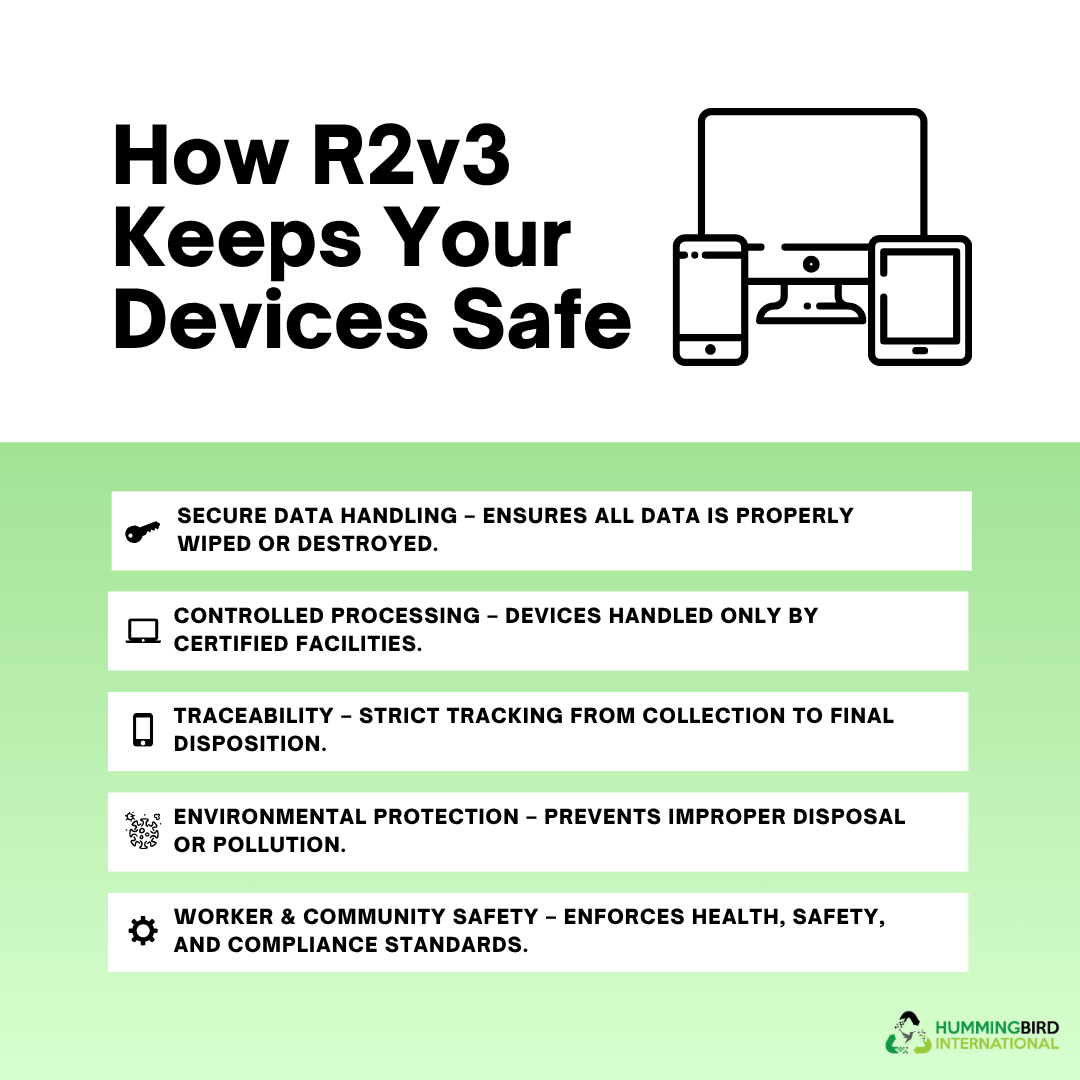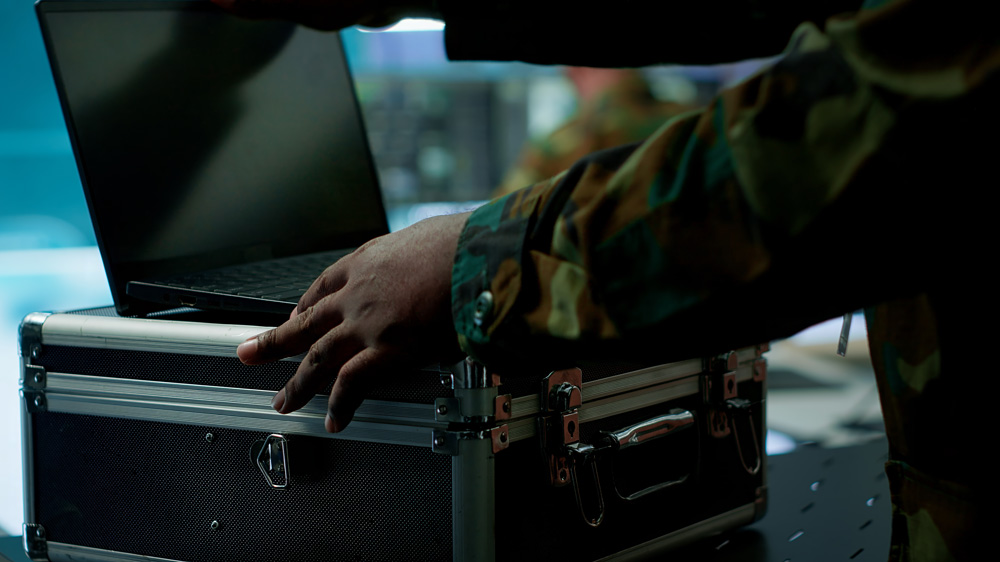Is your data safe once you retire your laptop? Not sure? This is one of the most important things to consider before you throw or recycle your electronic assets. And that’s why Hummingbird International offers its customers an R2v3-certified service, so you know your data is safe.
A Recap on R2v3 Certification
As you already know, Hummingbird International, LLC has earned the official R2v3 certification. We’ve been striving to earn this certification and are excited to serve our customers with facilities that meet all standards for IT asset disposition, worker safety, and verified data destruction.

Why Our Certification Benefits You
When working with an R2v3-certified partner like us, you can rest assured that your retired devices are processed through the proper channel. This protocol is designed to protect not just the planet but also the people and their data. But would you like to know how our R2v3 certifications allow us to securely handle your devices and sensitive data?
Let’s dig right in!
How R2v3 Safeguards Electronic Devices
R2v3 is the latest and most technologically advanced version of the Responsible Recycling standard that Sustainable Electronics Recycling International developed. As the tech world and security risks evolve, it is important to keep up and use stricter data security and safe recycling, which is now possible with R2v3.

Here’s how it works:
1. Certified Data Destruction Protocols
One of the biggest reasons why data is breached is because of the improper sanitization of old devices. But the R2v3 has strict protocols in place that use foolproof methods to make sure no data survives. This protocol includes:
International Data Wiping Standards
The R2v3 follows NIST 800-88, DoD 5220.22-M, and more international standards, allowing complete destruction. Other than the data wiping, the R2v3 also requires physical destruction of data by hard drive degaussing and shredding. It is a special requirement for storage devices where data wiping is not enough.
Here are some examples of devices and what sanitization or destruction methods should be used for them.
Military Devices

Image Source: Freepik.com/DC Studio
These devices may require degaussing, incineration, or shredding to remove and destroy data so that it is completely unrecoverable.
Corporate Devices

Image Source: Freepik.com/freepik
If the device is reused, the data can be overwritten securely using NIST SP 800-88 software.
Consumer Electronics

Image Source: Freepik.com/pressahotkey
If you intend to resell your device in the market later, standard wiping or encryption is enough to get the job done.
Once the data is wiped and the device destroyed, the clients receive number tracking and destruction certificates.
2. End-to-End Tracking
All R2v3-certified companies ensure end-to-end tracking from the moment a device is picked until it is disposed of responsibly, leaving no room for errors or complaints.
No Data Leaks
When you send the device for recycling, the asset is tagged with a unique identifier that helps track the device. Every stage of the cycle is documented. The stages involve transport, storage, data wiping, and the final recycling.
If you want detailed reports, all you have to do is request one. This is especially important for businesses that want to pass audits and testify to adherence to data privacy laws expected by agencies such as HIPAA and CCPA. Clients can see exactly when and where their device was wiped, resold, or destroyed.
This is a step-by-step breakdown of what happens when your device comes in for data sanitization:
- Pickup: Companies like Hummingbird International offer free curbside pickup with secure transport.
- Intake: Once the assets arrive at the facility, they are scanned and documented.
- Data Sanitization: After calculating the risk ratio, the devices are sanitized using different methods.
- Quality Control: The destruction is verified, and certificates are issued once everything is by the book.
- Downstream Processing: The salvageable devices are resold while the rest are safely recycled.
3. Security for Facilities and Staff
Not all companies can handle the requirements set by R2v3. There are stringent rules for the facilities and the staff. For instance, the devices are stored in restricted access areas and kept under surveillance at all times. Furthermore, the staff handling your equipment are hired after crucial background checks and undergo training to ensure R2v3 compliance.
Lastly, the company ensures that no process steps are compromised through regular audits. Companies are required to have incident response plans for when and if things go wrong. Facilities with R2v3 certification simulate data breach scenarios to prepare employees for any kind of data mishap.
4. Downstream Accountability
R2v3 is not just limited to the companies handling the initial handling, but it is also essential for the entire downward chain to comply with the R2v3 requirements.
Each vendor should be secure and meet environmental standards for compliant and efficient processing. With this, customers can trust that their devices do not end up in illegal and unsafe e-waste dumps.
5. Data Handling Based on Risk
In the earlier R2v3 versions, the devices weren’t dealt with according to the risk factor. However, now facilities have to use a risk-based approach to manage all data-bearing devices. This means that as soon as a device comes in, they must evaluate its risk level before deciding whether to handle it.
| Device Example | Risk Level | Required Sanitization Method |
| Government Laptop | High | Wiping + full physical destruction |
| Corporate Server | High | Multi-pass wiping + degaussing |
| Employee Work Laptop | Medium | Secure wiping using NIST SP 800-88 |
| Personal Smartphone | Medium | Standard wipe + encryption reset |
| Smart TV / IoT device | Low | Quick wipe; account unlinking |
This is a great update as not all devices have the same level of sensitivity, and while some pose little risk, others pose much higher. For instance, if a government-owned laptop comes in for recycling, it will require a great deal of destruction, while a normal smartphone may only require a standard swipe.
Here are some things that are considered in the risk assessment:
- What type of data could be stored on it?
- What was the device previously used for?
- What are the consequences of a possible security breach?
Answers to these questions will determine whether the security measures match the level of threat.
Environment and Data Security – What Does R2v3 Do?
When you think about data handling, you must consider whether it is safe, but do you ever consider whether it’s environmentally friendly? Many hazardous materials, including lead, cadmium, and mercury, are in devices that can pollute the environment and must be disposed of responsibly.
However, not all device components are disposed of. Some are salvaged so they can be recycled and not end up in a landfill. The circular economy principle, followed by R2v3, gives electronic components another chance at life, making them reusable.
What Devices Require Secure Sanitization?
For most people, data sanitization is limited only to laptops and smartphones. But any device that stores information or can transmit details poses a data breach risk.
Here is a list of devices that may require data sanitization:
| Device Category | Examples of Devices |
| Computers & Storage Devices | Desktops, Laptops, Servers, SSDs, HDDs, External Drives, USBs |
| Networking Equipment | Routers, Switches, Firewalls, Modems |
| Office Electronics | Printers, Copiers, Fax Machines |
| Telecom Devices | IP Phones, VoIP Equipment, PBX Systems |
| Smart Devices | Tablets, Smartwatches, Smart TVs, IoT Devices (Security Cameras, Smart Assistants) |
| Medical Equipment | MRI Scanners, Ultrasound Devices, Diagnostic Machines |
| Retail & Finance Machines | ATMs, POS Systems, Barcode Scanners |
| Other Electronics | DVRs, GPS Systems, Automotive Infotainment Units |
Can My Smart Fridge Cause a Data Breach?
Many, if not all, devices carry data even if you think they don’t. For example, every time you call your smart home assistant, it stores data. Or if you use a digital camera, it still may record data that you might not want to be leaked. The same goes for car infotainment systems.
In such cases, always think twice before throwing out these seemingly harmless devices, as they might still contain your data.
What Data Sanitization Mistakes Should You Avoid?
Why put your sensitive data at risk when you can easily sanitize it, and no, basic measures are not enough. These common data sanitization mistakes should be avoided at all costs:
1. Factory Reset Is Enough
No, it’s not. Factory data may remove the files on the surface, but they might still linger. A skilled hacker will be able to access your deleted data in a few seconds.
2. Just Clean My Phone
But what about your printer? Your speaker? And surely your router. All of these not-so-traditional devices can hold trade secrets you don’t want out.
3. Thank You for Sanitizing My Laptop!
But where’s the proof? If you assume that they’ve sanitized your data, chances are they haven’t. You must always ask for a Certificate of Data Destruction. Facilities certified by R2v3 provide these certificates as a standard practice.
4. No Thanks, I’ll Just Keep My Devices at Home
What makes your data safe, even if locked up in your attic? Hoarding electronics will only put you in harm’s way. It is better to securely dispose of your assets rather than storing them.
Conclusion
Are you not using your device anymore? Dispose of it! Secure disposal is important to protect your data and avoid cybersecurity issues later on. The R2v3 has set high standards and strict protocols to ensure your assets are disposed of, data is deleted, and the whole process is extremely transparent.
Hummingbird International is a certified R2v3 recycler and offers top-grade service to give you peace of mind and keep your data as safe as possible.
FAQs
How long does the data destruction process take?
The time depends on the type and number of devices being processed, as well as the chosen sanitization method. Most R2v3-certified facilities provide an estimated timeline upfront, often completing small batches within 24–48 hours and larger corporate collections within a few days.
What happens if my device contains proprietary or highly sensitive information?
R2v3 standards require a risk-based approach, ensuring devices with highly sensitive or proprietary data undergo stricter destruction methods, such as degaussing, shredding, or incineration. You can also request special handling protocols tailored to your security needs.
Can R2v3-certified recycling services help with compliance audits?
Absolutely. Certified recyclers provide documentation, certificates of destruction, and detailed tracking reports that support compliance with HIPAA, CCPA, GDPR, and other regulatory frameworks. This ensures organizations can demonstrate secure disposal practices during audits.
Are mobile apps and cloud data covered by R2v3 standards?
R2v3 primarily addresses physical devices, but certified providers often offer guidance on ensuring cloud accounts and mobile apps are securely wiped or decommissioned. This ensures sensitive information is removed from all potential storage locations.


Leave a Reply